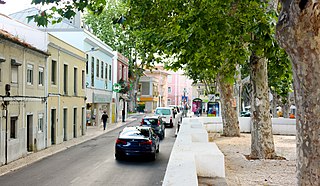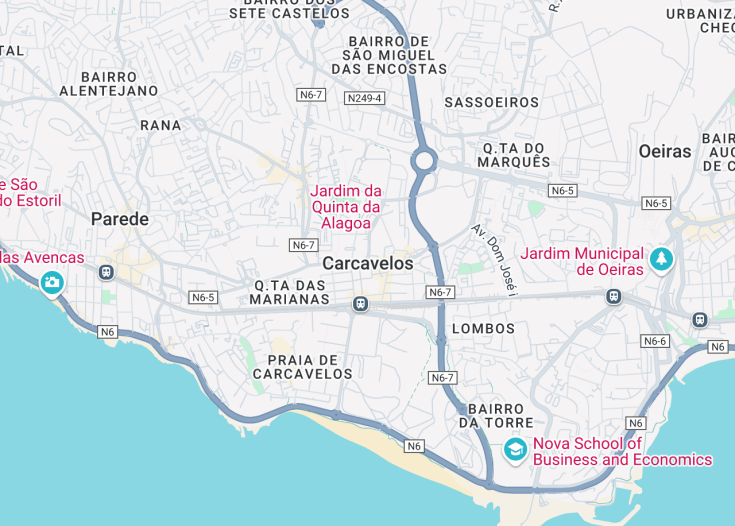Nestled on the sun-kissed Estoril Coast of Portugal, Carcavelos boasts an enviable blend of sandy beaches, historical sites, and vibrant cultural experiences. This charming locale is renowned for its sprawling beach, Carcavelos Beach, which is a haven for surfers and sunbathers alike.
Additionally, the town offers exquisite local cuisine and wines, notably the fortified wine of the region. Carcavelos serves as a perfect escape for those looking to enjoy coastal pleasures while having easy access to the capital city of Lisbon.
For an unforgettable experience, visit the São Julião da Barra Fort, an impressive historical military fort that offers panoramic views of the Atlantic Ocean.
Time your visit to coincide with the local market days to enjoy fresh produce and traditional crafts, enriching your travel experience with authentic local flavor.
Top things to do & see in Carcavelos
Select the following sights and activities to discover best tickets and tours available in Carcavelos.
Carcavelos: A Seaside Gem in Portugal
| Country | Portugal |
| Time in Carcavelos | GMT |
| Language spoken | Portuguese |
| Population | 21,536 (source: Data from local statistics, 2021) |
| Currency | Euro (€, EUR) |
| Airports |
|
Carcavelos is a lively coastal town in the Lisbon District of Portugal, renowned for its long sandy beach, vibrant community, and historical significance. Situated between the bigger cities of Lisbon and Cascais, this town offers a unique blend of cultural heritage and modern leisure facilities, making it a popular destination for both tourists and locals.
Historically, Carcavelos was known for its fortified wine, Carcavelos wine, which was exported globally in the 18th and 19th centuries. The town has a rich history, evident in places like the São Julião da Barra Fortress, which served as a coastal defense and a state prison. Today, the fortress is one of the town’s prominent landmarks, offering visitors a glimpse into Portugal’s maritime history.
Aside from its historical allure, Carcavelos thrives with contemporary attractions including surfing, with Carcavelos Beach being one of the best surfing spots in the region. The beach hosts several international surfing competitions, drawing competitors and spectators from all around the world. Its expansive seafront provides ample space for sunbathing, volleyball, and other beachside activities, making it a focal point for leisure and entertainment throughout the year.
Carcavelos is also a significant educational hub, home to the New University of Lisbon’s Faculty of Human Sciences, which attracts students nationally and internationally. This combination of education, history, and leisure helps sustain a dynamic community that values both its traditions and contemporary developments.
The local cuisine is another highlight, featuring fresh seafood that is a staple in many restaurants and cafes along the waterfront. Traditional dishes such as grilled fish, seafood stew, and pastéis de nata provide a taste of Portuguese culture and culinary expertise.
Accessible by road and public transport from major urban centers, Carcavelos remains an attractive destination for day trips or longer stays. Its proximity to Lisbon provides additional opportunities for visitors to explore the capital’s cultural scenes and return to the serene beachside atmosphere of Carcavelos by evening.
Where is Carcavelos?
Carcavelos is a charming coastal town located in the Lisbon District of Portugal, about 12 miles west of the capital city, Lisbon.
Distances:
| Route | Distance by car | Time by car |
|---|---|---|
| Lisbon to Carcavelos | 12 mi / 19 km | 20 minutes |
| Porto to Carcavelos | 198 mi / 318 km | 3 hours |
| Faro to Carcavelos | 195 mi / 314 km | 2 hours 45 minutes |
What is Carcavelos famous for?
Carcavelos is widely celebrated for its expansive sandy beach which is a top destination for surfing enthusiasts. The town’s rich history and proximity to Lisbon also add to its appeal.
History
Prehistoric to Medieval Times
Historians believe that the area around Carcavelos was inhabited by various prehistoric communities, evidence of which can be found in the numerous archaeological sites that dot the region. The strategic location on the Estoril coast near Lisbon made it a valuable site for settlements over the centuries. By the time of the Romans, Carcavelos was already a well-established village, primarily engaging in fishing and agriculture.
15th Century to 18th Century
The significant history of Carcavelos began to take shape during the Age of Discoveries when Portugal emerged as a global maritime power. The region benefited economically from its proximity to Lisbon and the maritime routes. The development of the fortification, Fort of São Julião da Barra, during the 16th century, emphasized its strategic importance in defending the coastline and the mouth of the Tagus River against invasions.
19th Century to Present
The modern era brought new developments to Carcavelos. In the 19th century, the region saw the cultivation of vineyards that would produce the renowned Carcavelos wine, a fortified wine that gained international fame. The 20th century underscored a shift towards urbanization and tourism, transforming Carcavelos into a popular destination for both Portuguese and international visitors. Today, it melds its rich history with modern attractions, offering a unique cultural and leisure experience.
Visit Carcavelos
What to see and do in Carcavelos
Explore the beautiful beaches of Carcavelos, notably Praia de Carcavelos, which is famed for its vast golden sands and excellent surf conditions. Here’s a list of recommended activities:
- Visit the Fort of São Julião da Barra at the eastern edge of Carcavelos beach for a dive into history.
- Enjoy watersports, particularly surfing, or enroll in a surf school to learn the basics.
- Stroll along the promenade and enjoy the local cuisine at the beachside restaurants.
- Taste the local specialty, Carcavelos wine, at a nearby vineyard or wine cellar.
Festivals and Events in Carcavelos
Carcavelos hosts several annual events that attract both locals and tourists. The Carcavelos Wine Festival in October celebrates the region’s wine heritage, while the Summer Music Festival in July brings live music performances to the beachfront.
Best time to visit Carcavelos
The optimal time to visit Carcavelos is during the late spring and summer months, from May to September, when the weather is warm and sunny, ideal for beach activities and outdoor exploring.
Is Carcavelos worth visiting?
Carcavelos is indeed worth visiting for anyone looking to explore a region that blends rich historical significance with beachfront leisure.
The combination of its cultural heritage, excellent beaches, formidable fortifications, and delicious local wines provides a comprehensive tourist experience. It is especially recommended for those interested in historical sites and beach activities.










